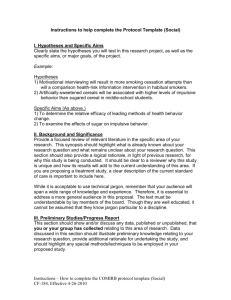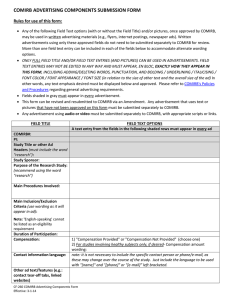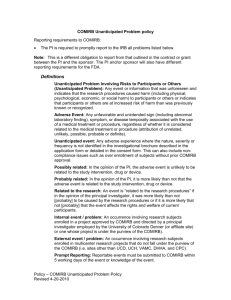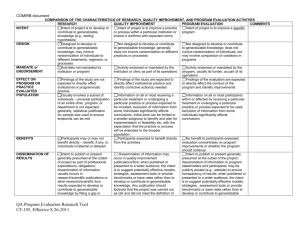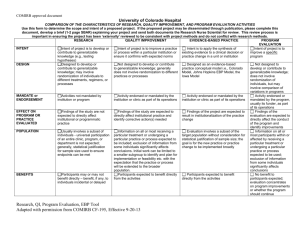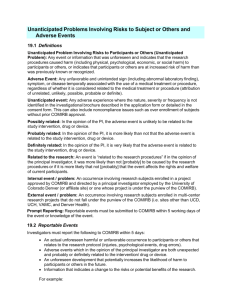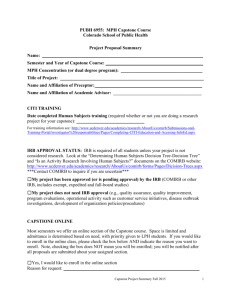criteria-for-irb-approval-of-research
advertisement
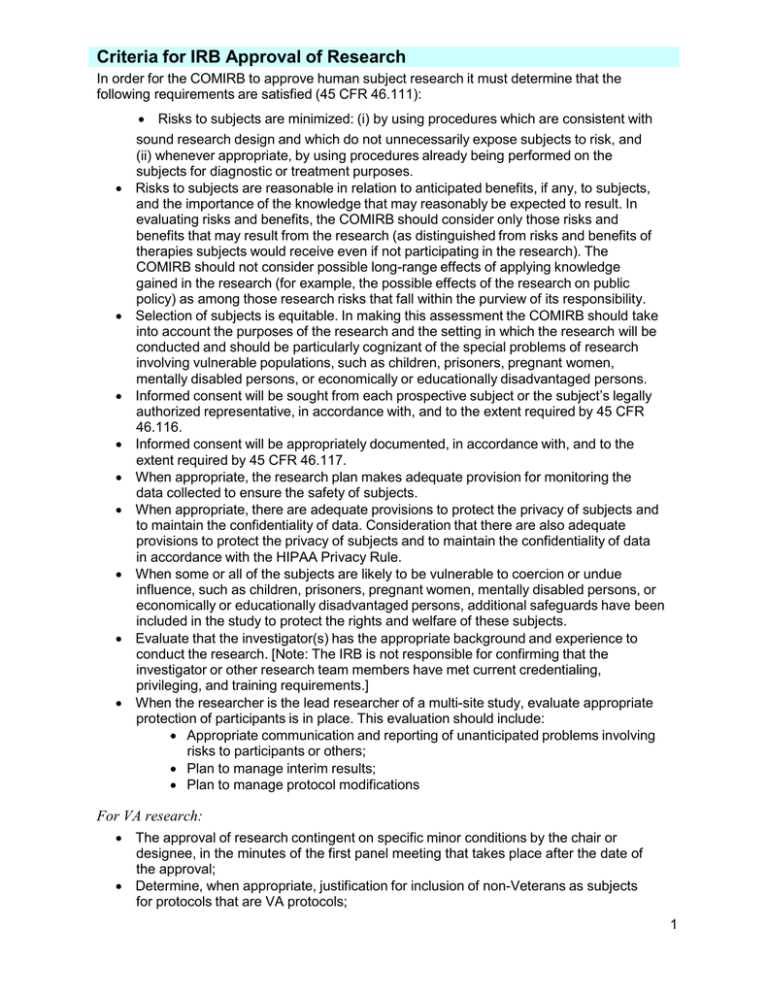
Criteria for IRB Approval of Research In order for the COMIRB to approve human subject research it must determine that the following requirements are satisfied (45 CFR 46.111): Risks to subjects are minimized: (i) by using procedures which are consistent with sound research design and which do not unnecessarily expose subjects to risk, and (ii) whenever appropriate, by using procedures already being performed on the subjects for diagnostic or treatment purposes. Risks to subjects are reasonable in relation to anticipated benefits, if any, to subjects, and the importance of the knowledge that may reasonably be expected to result. In evaluating risks and benefits, the COMIRB should consider only those risks and benefits that may result from the research (as distinguished from risks and benefits of therapies subjects would receive even if not participating in the research). The COMIRB should not consider possible long-range effects of applying knowledge gained in the research (for example, the possible effects of the research on public policy) as among those research risks that fall within the purview of its responsibility. Selection of subjects is equitable. In making this assessment the COMIRB should take into account the purposes of the research and the setting in which the research will be conducted and should be particularly cognizant of the special problems of research involving vulnerable populations, such as children, prisoners, pregnant women, mentally disabled persons, or economically or educationally disadvantaged persons. Informed consent will be sought from each prospective subject or the subject’s legally authorized representative, in accordance with, and to the extent required by 45 CFR 46.116. Informed consent will be appropriately documented, in accordance with, and to the extent required by 45 CFR 46.117. When appropriate, the research plan makes adequate provision for monitoring the data collected to ensure the safety of subjects. When appropriate, there are adequate provisions to protect the privacy of subjects and to maintain the confidentiality of data. Consideration that there are also adequate provisions to protect the privacy of subjects and to maintain the confidentiality of data in accordance with the HIPAA Privacy Rule. When some or all of the subjects are likely to be vulnerable to coercion or undue influence, such as children, prisoners, pregnant women, mentally disabled persons, or economically or educationally disadvantaged persons, additional safeguards have been included in the study to protect the rights and welfare of these subjects. Evaluate that the investigator(s) has the appropriate background and experience to conduct the research. [Note: The IRB is not responsible for confirming that the investigator or other research team members have met current credentialing, privileging, and training requirements.] When the researcher is the lead researcher of a multi-site study, evaluate appropriate protection of participants is in place. This evaluation should include: Appropriate communication and reporting of unanticipated problems involving risks to participants or others; Plan to manage interim results; Plan to manage protocol modifications For VA research: The approval of research contingent on specific minor conditions by the chair or designee, in the minutes of the first panel meeting that takes place after the date of the approval; Determine, when appropriate, justification for inclusion of non-Veterans as subjects for protocols that are VA protocols; 1 Determine when real Social Security Numbers (SSNs), scrambled SSNs, or the last four digits of SSNs will be used in the study. The summary must include the security measures that are in place to protect the SSN instances embedded in the study. [Note: This does not apply if the only use of SSNs is on the informed consent form or the HIPAA authorization as required by VHA Handbook 1907.01]. In addition to determining compliance with the HIPAA privacy rule, the minutes must take into consideration the requirements of 45 CFR 160 and 164, and other laws regarding protection and use of Veterans’ Information, including the Privacy Act of 1974, 5 U.S.C 552a; VA Claims Confidentiality Statute, 38 U.S.C 5701; Confidentiality of Drug Abuse, Alcoholism and Alcohol Abuse, Infection with Human Immunodeficiency Virus (HIV), and Sickle Cell anemia Medical Records, 38 U.S.C 7332; and Confidentiality of Healthcare Quality Assurance review Records, 38 U.S.C 5705. Determine that applicable VHA and VA information security policies pertaining to research are implemented. For VA multi-site research: The PI and all local site researchers must obtain written approvals from the relevant local VA facilities’ IRBs of record and all other local committees, subcommittees, and other approvals according to the respective applicable local, VA and other federal requirements. Research cannot be initiated at any given site until the local researcher has obtained written notification that the research can be initiated from the local associate chief of staff for research and development. 13.1 Risk/Benefit Assessment The goal of the assessment is to ensure that the risks to research subjects posed by participation in the research are justified by the anticipated benefits to the subjects or society. Toward that end, the COMIRB must: Judge whether the anticipated benefit, either of new knowledge or of improved health for the research subjects, justifies asking any person to undertake the risks; Disapprove research in which the risks are judged unreasonable in relation to the anticipated benefits. The assessment of the risks and benefits of proposed research - one of the major responsibilities of the COMIRB - involves a series of steps: Identify the risks associated with the research, as distinguished from the risks of therapies the subjects would receive even if not participating in research; Determine whether the risks will be minimized to the extent possible; Identify the probable benefits to be derived from the research; Determine whether the risks are reasonable in relation to the benefits to subjects, if any, and assess the importance of the knowledge to be gained; Ensure that potential subjects will be provided with an accurate and fair description of the risks or discomforts and the anticipated benefits. 13.2 Risks to Subjects are Minimized By using procedures which are consistent with sound research design and which do not unnecessarily expose subjects to risk; and Whenever appropriate, by using procedures already being performed on 2 the subjects for diagnostic or treatment purposes. 13.3 Risks to Subjects are Reasonable in Relation to Anticipated Benefits In evaluating risks and benefits, the COMIRB should consider only those risks and benefits that may result from the research - as distinguished from risks and benefits of therapies subjects would receive even if not participating in the research. The COMIRB should not consider possible long-range effects of applying knowledge gained in the research (e.g., the possible effects of the research on public policy) as among those research risks that fall within the purview of its responsibility. 13.4 Scientific Merit In order to assess the risks and benefits of the proposed research, the COMIRB must determine that: The research uses procedures consistent with sound research design; The research design is sound enough to reasonably expect the research to answer its proposed question; and The knowledge expected to result from this research is sufficiently important to justify the risk. In making this determination, the COMIRB may draw on its own knowledge and disciplinary expertise, or the COMIRB may draw on the knowledge and disciplinary expertise of others, such as reviews by the CCTSI Scientific Advisory Review Board, a funding agency, or departmental review. 13.5 Selection of Subjects is Equitable The COMIRB will review the recruitment methods and inclusion/exclusion criteria for the research to ensure equitable selection of subjects. In making this assessment the COMIRB takes into account the purposes of the research and the setting in which the research will be conducted, and is particularly cognizant of the special problems of research involving vulnerable populations, such as children, prisoners, fetuses, pregnant women, human in vitro fertilization, persons who are decisional challenged, or persons who are economically or educationally disadvantaged (see Vulnerable Populations). 13.6 Recruitment of Subjects Potential subjects cannot be specifically identified or contacted until COMIRB approval for the research has been obtained. It is possible to obtain general data relating to the availability of a specific population to ascertain the feasibility of the study. There are a number of ways to recruit subjects: Clinical Relationship Existing research relationship HIPAA A Authorization Recruitment database Advertisements 13.7 Students as Subjects When UCD students and/or employees are being recruited as potential subjects, researchers must ensure that there are additional safeguards for these subjects. The voluntary nature of 3 their participation must be primary and without undue influence on their decision. Researchers must emphasize to subjects that neither their academic status nor grades or their employment will be affected by their participation decision. To minimize coercion, investigators should avoid, whenever possible, the use of their students and employees in procedures which are neither therapeutic nor diagnostic. In these latter situations, investigators should solicit subjects through means such as bulletin board notices, flyers, advertisements in newspapers, and announcements in classes other than their own. When entering a classroom to recruit students and conduct research, e.g. administer a survey, investigators must do so at the end of the class period to allow nonparticipating students the option of leaving the classroom, thereby alleviating pressure to participate. 13.8 Finders Fees and Incentives Finder’s fees include any payment or gift to an individual who identifies a prospective subject. Principal Investigators and research personnel may not individually receive incentive payments or finder’s fees on a per participant basis. PIs may accept monetary rewards that are offered by the sponsor only after the research is closed to enrollment and only if the reward is directed to the research team as a whole (e.g. funds allocated for purchasing educational materials or to support attendance at educational conferences). Note: For faculty and staff employed by the Denver VA: Questions regarding finder’s fees and incentives involving VA studies should be directed to the Denver VA Research Office or VA regional counsel. 13.9 Advertisements The investigator will provide the COMIRB with all recruiting materials to be used in identifying participants including: the information contained in the advertisement, the mode of its communication; the final copy of printed advertisements; the final audio/video taped advertisements. The COMIRB must approve any and all advertisements prior to posting and/or distribution. The COMIRB may review: The information contained in the advertisement. The mode of its communication. The final copy of printed advertisements. The final audio/video taped advertisements. This information should be submitted to the COMIRB with the initial application or as an addendum to the protocol. The COMIRB reviews the material to assure that the material is accurate and is not coercive or unduly optimistic, creating undue influence to the subject to participate which includes but is not limited to: Statements implying a certainty of favorable outcome or other benefits Claims, either explicitly or implicitly, that the drug, biologic or device was safe or effective for the purposes under investigation Claims, either explicitly or implicitly, that the test article was known to be equivalent or superior to any other drug, biologic or device Using terms like “new treatment,” “new medication,” or “new drug” without explaining that the test article was investigational Promising “free medical treatment” when the intent was only to say participants will 4 not be charged for taking part in the investigation Emphasis on payment or the amount to be paid, such as bold type or larger font on printed media Does not include exculpatory language. Offers by the sponsor to include a coupon good for a discount on the purchase price for the product once it has been approved for marketing. Any advertisement to recruit subjects should be limited to the information the prospective subjects need to determine their eligibility and interest. 13.10 Payment to Subjects Payment to research subjects is a way to reimburse a subject for travel and other experiences incurred due to participation. However, payment for participation is not considered a research benefit. Regardless of the form of remuneration, investigators must take care to avoid coercion of subjects. Payments should reflect the degree of risk, inconvenience, or discomfort associated with participation. The amount of compensation must be proportional to the risks and inconveniences posed by participation in the study. The panel must review both the amount of payment and the proposed method of disbursement to assure that neither entails problems of coercion or undue influence. Credit for payment should accrue and not be contingent upon the participant completing the entire study. Any amount paid as bonus for completion of the entire study should not be so great that it becomes coercive. At the VA MEDICAL CENTER (VAMC), payment may be permitted, with COMIRB approval, in the following circumstances: No Direct Subject Benefit. When the study to be performed is not directly intended to enhance the diagnosis or treatment of the medical condition for which the volunteer subject is being treated, and when the standard of practice in affiliated non-VA institutions is to pay subjects in this situation. Others Being Paid. In multi-institutional studies, when human subjects at a collaborating non-VA institution are to be paid for the same participation in the same study at the same rate proposed. Comparable Situations. In other comparable situations in which, in the opinion of the IRB, payment of subjects is appropriate. Transportation Expenses. When transportation expenses are incurred by the subject that would not be incurred in the normal course of receiving treatment and which are not reimbursed by any other mechanism. 13.11 Informed Consent The COMIRB will ensure that informed consent will be sought from each prospective subject or the subject’s legally authorized representative, in accordance with, and to the extent required by 45 CFR 46.116 and 21 CFR 50.20. In addition, the Committee will ensure that informed consent will be appropriately documented in accordance with, and to the extent required by 45 CFR 46.117 and 21 CFR 50.27. See section 14 for a detailed discussion of informed consent requirements. 13.12 Data Safety Monitoring The COMIRB will review the data safety monitoring plan for protocols involving more 5 than minimal risk during initial review and at continuing review. The data and safety monitoring plan for prospective studies must include, but is not limited to, the following: a. What safety information will be collected; b. How the safety information will be collected (e.g. with case report forms, at study visits, by telephone calls with subjects) c. The frequency of data collection including when safety data collections starts; d. If not using a DMC, and if applicable, statistical tests for analyzing the safety data to determine if harm is occurring; e. Provisions for the oversight of safety data (e.g. by a DMC, Safety Officer or PI) f. Conditions that trigger an immediate suspension of the research, if applicable g. A discussion with the subject of potential study outcomes that may have an effect on the subject’s health or well-being; and h. A procedure to determine when and how to notify individual subjects or their health care providers of findings that may affect the subjects’ health. The data and safety monitoring plan for retrospective studies must include, but is not limited to, the following: a. Monitoring for and reporting any breach of confidentiality. For DoD regulated research, a medical monitor should be appointed when appropriate for studies involving more than minimal risk to subjects. 13.12.1 Differentiating Usual Care from Research The COMIRB ensures that the PI has clearly identified the “usual care” aspects of the study from any research interventions. Usual care is what the subject would experience if s/he was not in the study. Usual care may be limited to one ‘arm’ of the study or is being delivered to all subjects as part of the study. Usual care components can become research procedures if the protocol dictates their delivery (including timing, dose, or choice of treatment), rather than the delivery decisions being made within the patient- provider relationship. When a study involves ‘usual care,’ COMIRB ensures that the investigator must clearly designate the individual or entity responsible for relevant aspects of both the research and the usual care. The COMIRB ensures that subjects will be able to identify which activity is research, and which is usual care, and know who (the researcher or the subject’s health care provider) is responsible for: a) Explaining potential risks and benefits of the treatment or service to the subject; b) Providing the treatment or service; c) Monitoring the treatment or service, as applicable; d) Defining whether the adverse events result from usual care or research, as applicable; e) Alerting the subject if there is a problem with the treatment or service (e.g., a newly discovered disk, a product recall); and f) Documenting the subject’s clinical course while receiving the treatment 6 or service, as applicable 13.12.2 Enlisting Clinical Expertise The COMIRB ensures that the investigator provides for clinical expertise. If the investigator is not a clinician, when appropriate, the protocol must have provisions for enlisting the services of a clinician with appropriate expertise and privileges to perform duties that may include, but not be limited to: a) Reviewing the data, adverse events, and new study findings; and b) Making required decisions to protect the health of the subject (e.g., stopping the participant’s involvement in the study or determining when to notify the subject or the subject’s health care provider of information that may affect the health of the subject). 13.13 Privacy and Confidentiality At the time of initial review, the COMIRB ensures that the privacy and confidentiality of research subjects is protected. The COMIRB assesses whether there are adequate provisions to protect subject privacy and maintain confidentiality. The COMIRB does this through the evaluation of the methods used to obtain information: About subjects, About individuals who may be recruited to participate in studies The use of personally identifiable records and The methods to protect the confidentiality of research data. The PI will provide the information regarding the privacy and confidentiality of research subjects at the time of initial review through the completion of the application, any necessary HIPAA Forms, research protocol, and/or other submitted, applicable materials. The COMIRB will review all information received from the PI and determine whether or not the privacy and confidentiality of research subjects is sufficiently protected. In some cases, the COMIRB may also require that a Certificate of Confidentiality be obtained to additionally protect research data (See Section 25.1). 13.13.1 Definitions Privacy - having control over the extent, timing, and circumstances of sharing oneself (physically, behaviorally, or intellectually) with others. Confidentiality - methods used to ensure that information obtained by researchers about their subjects is not improperly divulged. Private information - information which has been provided for specific purposes by an individual and which the individual can reasonably expect will not be made public (for example, a medical record). Identifiable information – information where the identity of the subject is or may readily be ascertained by the investigator or associated with the information directly or with a key to a code. 13.13.2 Privacy The COMIRB must determine whether the activities in the research constitute an invasion of privacy. In order to make that determination, the COMIRB must obtain information regarding how the investigators are getting access to subjects or subjects’ information and the subjects expectations of privacy in the situation. Investigators must have appropriate authorization to access the subjects or the 7 subjects’ information. In developing strategies for the protection of subjects’ privacy, consideration should be given to: a. Methods used to identify and contact potential participants b. Settings in which an individual will be interacting with an investigator c. Appropriateness of all personnel present for research activities d. Methods used to obtain information about participants and the nature of the requested information e. Information that is obtained about individuals other than the “target participants,” and whether such individuals meet the regulatory definition of “human participant” (e.g., a subject provides information about a family member for a survey) f. How to access the minimum amount of information necessary to complete the study. 13.13.3 Confidentiality Confidentiality and anonymity are not the same. If anyone, including the investigator, can readily ascertain the identity of the subjects from the data, then the research is not anonymous and the COMIRB must determine if appropriate protections are in place to minimize the likelihood that the information will be inappropriately divulged. The level of confidentiality protections should be commensurate with the potential of harm from inappropriate disclosure. In reviewing confidentiality protections, the IRB shall consider the nature, probability, and magnitude of harms that would be likely to result from a disclosure of collected information outside the research. It shall evaluate the effectiveness of proposed deidentification techniques, coding systems, encryption methods, storage facilities, access limitations, and other relevant factors in determining the adequacy of confidentiality protections. 13.14 Vulnerable Populations The COMIRB determines if appropriate additional safeguards are in place to protect the rights and welfare of subjects if they are likely to be members of a vulnerable population (e.g., persons with diminished autonomy). 13.15 Information Security The COMIRB determines if an appropriate information security plan is in place. 1) For VA research only: This plan will also need to be reviewed and approved by the ISO. Any concerns of the ISO will be forwarded to COMIRB for consideration. The plan must clearly identify, and include, but not be limited to: a) Whether or not individually identifiable information is to be collected or used; b) How the data is to be collected or acquired; c) Where the data (original and all copies) is to be stored and corresponding security systems; d) How the data is to be transported or transmitted from one location to another; e) Who is to have access to the data and how they are to access it (anyone who has access to the data is responsible for its security); f) All entities or individuals outside VHA to whom the data is to be disclosed, and the justification for such disclosure and the authority (e.g., the HIPAA 8 authorization); g) Who is to have access and be responsible for the security of the information (e.g., the Coordinating Center, the statistician, and PI who has ultimate responsibility); h) Mechanisms used to account for the information; i) Security measures that must be in place to protect individually identifiable information if collected or used; and j) How and to whom a suspected or confirmed loss of VA information is to be reported. 2) Providing for Reuse of Data The COMIRB determines if the data may be reused in other studies, by reviewing: The research data repository plan outlining where and how the data is to be stored; The research informed consent and HIPAA authorization(s) associated with the protocol or the request for these to be waived. If COMIRB does not waive the requirements then the informed consent and HIPAA authorization content must include language on the uses and disclosures of the data as defined in the protocol as well as information on how privacy and confidentiality will be maintained and how the data will be secured. If the creation and operation of the data repository is not included in the data collection protocol, there must be a separate COMIRB-approved protocol for the creation and operation of the data repository. 13.16 Flagging medical records for VA Research COMIRB has determined that all protocols must be flagged in the VHA Health Record unless the study is limited to secondary data or specimen use only. If a VA investigator thinks his/her study should not be required to flag subject medical records, the investigator may request the ACOS/R recommend waiving the flagging requirement. If in agreement with the investigator's rationale, the ACOS/R will provide a letter to COMIRB that can be submitted with the protocol. An indication in the COMIRB feedback letter that CPRS flagging requirement has been waived alleviates flagging responsibilities for that study. Note that by VA regulations, the mandatory flagging requirement will not be waived for studies that involve any of the following: ● Any invasive research procedure; ● Interventions that will be used in the medical care of the subject, or that could interfere with other care the subject is receiving or may receive; ● Clinical services that will be used in the medical care of the subject or that could interfere with other care the subject is receiving or may receive; ● The use of a survey or questionnaire that may provoke undue stress or anxiety. 9
